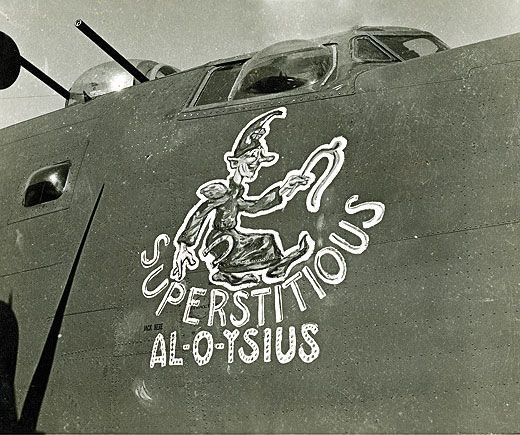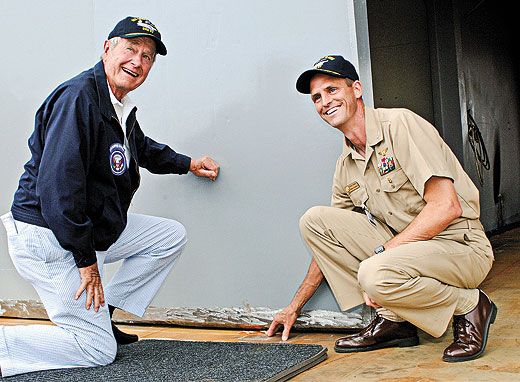One More For The Checklist
For some pilots, a good-luck charm is standard equipment.
/https://tf-cmsv2-smithsonianmag-media.s3.amazonaws.com/filer/One_more_for_checklist_FLASH.jpg)
From his tour in an Air Force-Navy exchange program, retired U.S. Air Force fighter pilot Ralph Wetterhahn remembers a Navy pilot who had an odd practice. It was during the Vietnam War, and they both flew A-7 Corsairs from the carrier USS America. Wetterhahn can’t remember the pilot’s name; what he does remember is that every time the guy flew a mission, he would take along a small, rubber Snoopy doll. “Snoopy’s mostly a white dog, right?” says Wetterhahn, an Air & Space/Smithsonian contributor. “Well, that damn thing was filthy from grease and so on in the airplane. He’d jam it into the notch between the panel and the windscreen.”
One day, as the pilot prepared to launch, he realized he’d forgotten Snoopy. “The guy went bananas,” Wetterhahn recalls. “He got on the radio and insisted his roommate go downstairs and find it. He wouldn’t take that catapult shot without it.” Having flown aircraft for both services, including F-4s and F-15s for the Air Force, Wetterhahn guesses that naval aviators as a group might be a bit more superstitious. “I suspect the Navy guys had more to worry about, with cat shots and arresting gear, et cetera.”
Maybe. But a few decades ago, Bill Wallrich, who served in the Army in World War II and Korea, wrote an article, “Superstition and the Air Force,” for the journal Western Folklore. “The United States Air Force, although it has been in existence but a short half century, has developed a vast and definite folklore peculiarly its own,” Wallrich wrote. Within that folklore, he explained, could be found a specialized vocabulary of slang and argot, sayings and jokes, legends and tall tales, songs and ballads, heroes and buffoons. And yes, superstitions.
As I interviewed pilots for this article, a mysterious pattern emerged. Many denied being superstitious, then quickly followed with “…but I can tell you about a pilot who is.” Perhaps superstition is in the eye of the beholder. But Wetterhahn makes a point about carrier aviation that could also apply in other circumstances: “You get a cold cat shot, and you don’t really have any control over that.”
Control. Superstitions emerge as mental hedges against danger in situations where so much is beyond a person’s control. With pilots frequently in those situations, a rich lore of flying superstitions has accumulated. Military aviation, especially in wartime, has been the most fertile ground.
Consider P-38 Lightning pilot Carl Mills, who flew in Italy for the U.S. Army Air Forces in World War II. Fellow P-38 pilot Dave Toomey remembers Mills as a top-notch flier, “but he wasn’t too keen about having his picture taken. It was sort of against his principle.” One day, Mills grudgingly allowed himself to be photographed just before a mission. “Then he went out and flew the mission, and wouldn’t you know he got his ass all shot up,” says Toomey. “Barely made it back on one engine. After that, if someone ever took a picture of him, he wouldn’t fly that day. I made the mistake of snapping his picture once, and he saw me do it and he really came at me. It took two guys to hold him back. He was rabid.”
During World War II, says Wallrich, the stress on pilots frequently produced superstitious behavior. The most common was the carrying of amulets and talismans like silver dollars, particularly (and counter-intuitively) when the numbers in the year added up to 13 (such as 1921), to correspond with that coin’s 13 stars and its eagle’s 13 tail feathers. Every unit had at least one bad-luck airplane—a “clinker,” in Wallrich’s words, whose temperamental behavior masked a darker jinx—and a charmed airplane that padded the odds for any pilot lucky enough to fly it.
Many airplanes flew with the name “Boomerang,” a reassuring omen for the crews because a boomerang always returns to where its flight began. The crew of the B-29 Boomerang, which flew 10 missions before its final one on August 15, 1945—the last bombing raid over Tokyo—carried a real boomerang on board, and all made it home safely.
In Vietnam, when Air Force pilot Dan Cherry flew combat missions in the F-105 and the F-4, he always wore a red bandana around his neck. “Definitely a good-luck charm,” he says today. “My mustache also served that purpose. The mustache was started the day before my first combat mission and not shaved off until putting feet down in the good ole USA after completing the tour. I wouldn’t dream of shaving it off…no matter how ugly it looked.”
Among the superstitious, the consensus seems to be: If it works, don’t mess with it. Before his present gig with the Federal Aviation Administration in Spokane, Washington, Steve Dunn made a career of flying DC-3s for Hollywood and wide-bodies for the airlines. Dunn remembers flying with a DC-10 captain for Hawaiian Airlines. Whenever the big jet taxied to the runway, the captain would crack his cockpit window and, in flagrant violation of procedures, light a cigarette. Dunn and the other officer, meanwhile, would run through the checklist. “Just before takeoff, he’d flick [the cigarette] out the window, close it, and push the throttles up,” says Dunn. “And that made you feel like ‘Here we go boys, we’re on our way.’ ” Dunn recalls that the rest of the crew didn’t want the captain involved in the checklist; they wanted him to do his ritual. “If he didn’t do that, we all felt awkward. We wanted him to smoke his cigarette.” He adds: “As young pilots, we felt that the plane respected him. If he was on board and did his routine, the plane would follow.”
Race pilots have a double whammy: They fly in hazardous conditions and can’t control the actions of other pilots in the event, and, like others involved in high-stakes sports, they are inclined to believe that luck plays a role. John Penney is known for dusting the competition in recent years at the Reno National Championship Air Races in the modified Grumman F8F-2 Bearcat Rare Bear. Penny’s superstitions started in Vietnam, when he flew combat missions in an A-7D Corsair out of Thailand. “A bunch of us had custom flying boots made by a merchant in downtown Korat, the ‘Good Luck Boot Shop.’ I wore mine on every combat mission and never took a hit from anti-aircraft guns, surface-to-air missiles, and such. That is not to say that wearing those boots necessarily brought me good luck and protected me from harm. However…” Years later, he says, when he started racing Rare Bear, his best wins and speed records, as well as his safest emergency landings, all happened when he was in those “Good Luck” boots. Last year he finished second in Rare Bear, behind a Strega flown by Steve Hinton Jr. On Penney’s feet that day were a brand of NASCAR/Indy racing shoes. “Enough of that,” he says. “This year my ‘Good Luck’ boots are going back on the race course.”
Superstition has even found its way into NASA, which has always selected its pilots from the military services. Space shuttle astronaut Robert “Hoot” Gibson, an ex-Navy fighter pilot, recalls that on launch day, the schedule gives the crew about 15 minutes between suiting up and heading to the pad. During that period, the astronauts would stand around a high table in the suit-up area, joined by the Chief of the Astronaut Office and the Director of Flight Operations. A deck of cards would appear, and they would play a homegrown game called Possum Fargo. Five-card hands were dealt. No betting, no further cards. Just a rapid deal. Whoever had the lowest hand won the round.
“It’s like poker, 180 degrees out,” says Gibson. “The lowest you could get was 2,3,4,5,7 [a 6 gave you a straight]. That was the winningest hand.” The crew could not leave until the commander of the mission won a hand—for good luck. “You were not ready to walk out of there until he won,” says Gibson. He doesn’t know who created the game or who named it. But he played it on every one of his five missions.
Four-time shuttle astronaut Tom Jones has a slightly different recollection of Possum Fargo. “We watched the commander play the card game in the suit-up room against the chief of the Flight Crew Operations Directorate,” says Jones. “Rest of the crew does not play, and I don’t know the game. My opinion is that the kind of people I crewed with did not get there by being superstitious, so it’s a trait bred out of the astronaut corps for the most part.” But he admits that the commander had to get that low hand before launch. “Once you lose, you can go out to the pad,” says Jones. Or win, he means, with that lousy hand.
As a magazine reporter, I’m not sure what to make of such superstitions. I’m not superstitious myself, but I once knew this copy editor….
Michael Klesius is an Air & Space associate editor.

